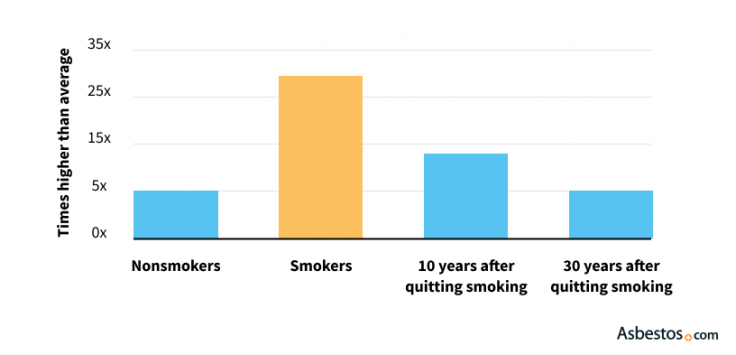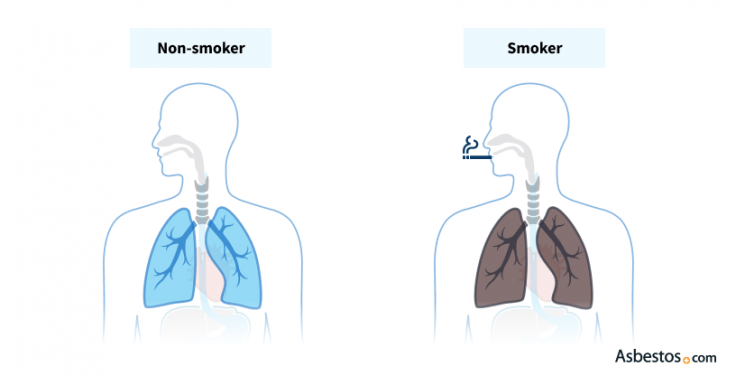
Yvonne Waterman, Ph.D., is the founder of the European Asbestos Forum and a specialist in asbestos litigation. Waterman has worked to build a global network of professionals fighting for a future without asbestos exposure and disease.
Smoking alone or in combination with asbestos exposure doesn't increase the risk of developing mesothelioma. But the risk of lung cancer multiplies significantly among those exposed to asbestos and cigarette smoke. Both smoking and asbestos can cause lung cancer.

Written by Michelle Whitmer | Scientifically Reviewed by Yvonne Waterman | Edited by Walter Pacheco
Smoking is the leading cause of preventable death in the U.S., and asbestos exposure is the No. 1 cause of occupational deaths worldwide. Exposure to both can have detrimental effects on respiratory health and cancer risk.
The combination of smoking and asbestos exposure greatly increases a person’s risk of developing lung cancer. It also may accelerate the onset of asbestosis and increase the severity of symptoms. Smoking affects the development and severity of asbestos-related diseases in several ways.
Smoking doesn’t increase the risk of developing mesothelioma among people exposed to asbestos. Scientists don’t know why this is true. They understand more about the increased risk of lung cancer. They believe it relates to the combined effects of smoking and asbestos.
Studies have estimated that between 50% and 80% of asbestos workers are smokers. This factor helps explain why asbestos-related lung cancer cases outnumber mesothelioma cases.

Many people may not realize asbestos causes lung cancer in addition to mesothelioma. As asbestos enters the lungs, it can damage the tissue within the lungs and the air sacs that help exchange air between your bloodstream and the outside air.
Smoking hasn’t been directly linked to mesothelioma. The primary cause of malignant mesothelioma is asbestos exposure. However, smoking is a risk factor for developing asbestos-related lung cancer. If asbestos exposure has occurred, you may have an increased risk of developing mesothelioma.
It was the most depressing appointment of my life. I could have guessed maybe lung cancer because I had been a smoker. But mesothelioma? No. A cancer caused by asbestos exposure wasn’t even on my radar.
Decades of research haven’t found an increased risk of mesothelioma among asbestos workers who smoke. Only one study from 2002 found a common gene mutation among a group of smokers with mesothelioma. A 2013 study looking deeper into the topic found no relationship.
Smoking does worsen the pulmonary symptoms of mesothelioma and reduces your body’s overall ability to heal. Doctors advise all patients with cancer or respiratory illnesses to avoid tobacco smoke.

We’ll get you the best specialist for your diagnosis and schedule appointments with them quickly.
Get StartedThe Centers for Disease Control and Prevention says smoking is the cause of 80% to 90% of lung cancer cases. Asbestos exposure is the primary cause in about 4% of U.S. cases, while a Japanese study showed asbestos may cause 12.8% of cases. A 2024 study confirmed asbestos exposure is associated with all types of lung cancer.
Both smoking and asbestos exposure can independently cause lung cancer. When combined, the risk of lung cancer becomes supra-additive, meaning the risk for smokers exposed to asbestos is greater than the sum of the individual risks. A 2013 study involving more than 50,000 medical records from insulation workers revealed how occupational asbestos exposure and smoking have a supra-additive effect on lung cancer death rates.
Death Rate of Asbestos Insulation Workers Associated With Smoking

Occupational asbestos exposure on its own was associated with a lung cancer death rate 5 times higher than average. When asbestos exposure was combined with smoking, the death rate was 28 times higher than average. Among those who also developed asbestosis, the death rate was 36.8 times higher.
The study also showed quitting smoking gradually reduces a person’s risk of lung cancer. Asbestos exposure’s health effects exposure are irreversible, however. Any amount of asbestos exposure contributes to the incidence of lung cancer, even in heavy smokers.
Smoking increases the risk of asbestosis among those exposed to asbestos. The Agency for Toxic Substances and Disease Registry’s research shows this risk.
Asbestosis is a chronic pulmonary disease in which the lungs undergo slow and repetitive scarring, or fibrosis. There is no known cure. The inhalation of asbestos fibers causes asbestosis. It’s most prevalent among workers with long and heavy exposure to asbestos.

A 1995 study concluded smokers have increased rates of asbestosis progression. An earlier report showed approximately 12% of asbestosis patients might develop lung cancer. Asbestos-exposed smokers with asbestosis have a significantly increased risk of lung cancer.
The effect of smoking on asbestosis has been a point of debate among researchers. Some experts believe smoking contributes to asbestosis and others challenge this notion. Significant evidence shows how much smoking can worsen symptoms of asbestosis, including breathlessness.

In the U.S., one tobacco product is known to have been manufactured with asbestos as an ingredient: Kent Micronite filtered cigarettes. From 1952 to 1956, H&V Specialties manufactured cigarette filters for the Lorillard Tobacco Company using a type of asbestos called crocidolite.
Lorillard marketed Kent Micronites as the safest cigarettes ever invented, claiming high-tech industrial filtration technology inspired the design. Unfortunately, crocidolite is now widely considered the most toxic form of asbestos.
Although crocidolite was used in certain specialized filters, the crimped crepe paper of the Micronite cigarette filter didn’t prevent consumers from inhaling microscopic crocidolite fibers when they smoked Kent cigarettes. One study found a smoker could inhale “an average of 170,000 crocidolite airborne structures” from only 2 puffs on a Kent Micronite.
In general, cigarette filters don’t make cigarettes significantly safer. The filters typically only trap the largest tar particles, allowing most of the toxic substances in cigarettes to pass through. The Kent Micronite filter made smoking more dangerous, adding asbestos to the list of cancer-causing substances smokers were exposed to.
Asbestos workers who smoke have a significant risk of developing lung cancer. If they develop asbestosis, smoking worsens symptoms and may make the disease progress at a faster rate.
Asbestos workers who smoke are 28 times more likely to die of lung cancer than the general population. Those who receive an asbestosis diagnosis have a higher risk. Asbestos-exposed smokers who develop asbestosis are 36.8 times more likely to die of lung cancer.
Asbestos workers who smoke should quit smoking to reduce their risk of developing lung cancer. Exposure to cigarette smoke and asbestos is associated with a supra-additive risk of lung cancer. Join a smoking cessation program immediately if you work with asbestos products.

Have a question? Contact one of our Patient Advocates and get the answers you need.

Connect, share stories and learn from the experiences of others coping with mesothelioma in one of our support groups.

We help support charities, hospitals and awareness groups working to help people impacted by asbestos and cancer.
Stay up-to-date on treatment, research, clinical trials, doctors and survivors
The information on this website is proprietary and protected. It is not a substitute for professional medical advice, diagnosis or treatment. Any unauthorized or illegal use, copying or dissemination will be prosecuted. Please read our privacy policy and terms of service for more information about our website.
This website and its content may be deemed attorney advertising. Prior results do not predict a similar outcome.
The Mesothelioma Center’s claim as the most trusted resource is based on our more than 150 5-star Google and BBB reviews. Our organization also helps more than half of all mesothelioma patients annually diagnosed.
Your web browser is no longer supported by Microsoft. Update your browser for more security, speed and compatibility.
If you are looking for mesothelioma support, please contact our Patient Advocates at (855) 404-4592
The Mesothelioma Center at Asbestos.com has provided patients and their loved ones the most updated and reliable information on mesothelioma and asbestos exposure since 2006.
Our team of Patient Advocates includes a medical doctor, a registered nurse, health services administrators, veterans, VA-accredited Claims Agents, an oncology patient navigator and hospice care expert. Their combined expertise means we help any mesothelioma patient or loved one through every step of their cancer journey.
More than 30 contributors, including mesothelioma doctors, survivors, health care professionals and other experts, have peer-reviewed our website and written unique research-driven articles to ensure you get the highest-quality medical and health information.
My family has only the highest compliment for the assistance and support that we received from The Mesothelioma Center. This is a staff of compassionate and knowledgeable individuals who respect what your family is experiencing and who go the extra mile to make an unfortunate diagnosis less stressful. Information and assistance were provided by The Mesothelioma Center at no cost to our family.LashawnMesothelioma patient’s daughter


Whitmer, M. (2025, August 18). Asbestos-Related Diseases and Smoking. Asbestos.com. Retrieved December 14, 2025, from https://www.asbestos.com/asbestos/smoking/
Whitmer, Michelle. "Asbestos-Related Diseases and Smoking." Asbestos.com, 18 Aug 2025, https://www.asbestos.com/asbestos/smoking/.
Whitmer, Michelle. "Asbestos-Related Diseases and Smoking." Asbestos.com. Last modified August 18, 2025. https://www.asbestos.com/asbestos/smoking/.
An occupational scientist or another expert who specializes in occupational hazards reviewed the content on this page to ensure it meets current scientific standards and accuracy.

Yvonne Waterman, Ph.D., is the founder of the European Asbestos Forum and a specialist in asbestos litigation. Waterman has worked to build a global network of professionals fighting for a future without asbestos exposure and disease.
Our fact-checking process begins with a thorough review of all sources to ensure they are high quality. Then we cross-check the facts with original medical or scientific reports published by those sources, or we validate the facts with reputable news organizations, medical and scientific experts and other health experts. Each page includes all sources for full transparency.
Please read our editorial guidelines to learn more about our content creation and review process.
